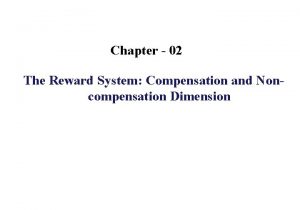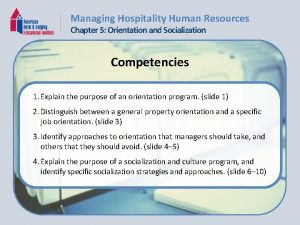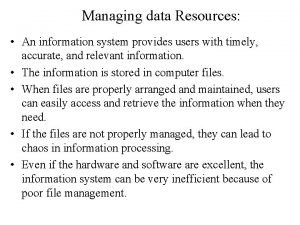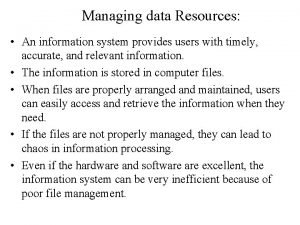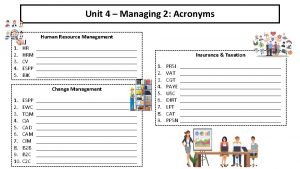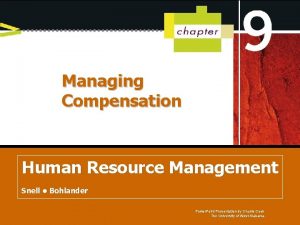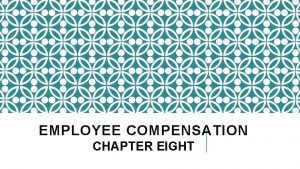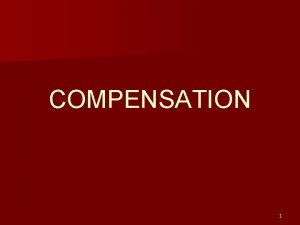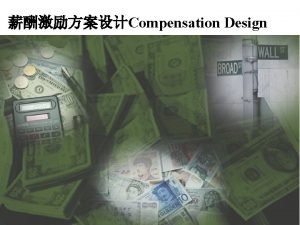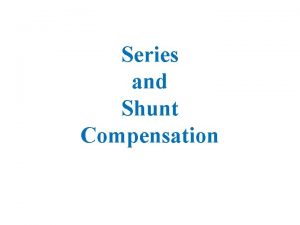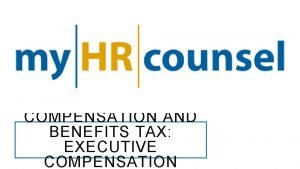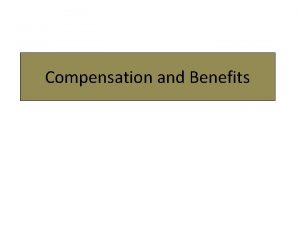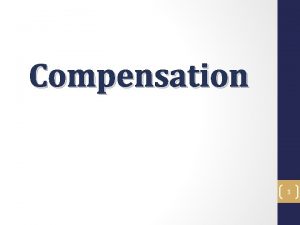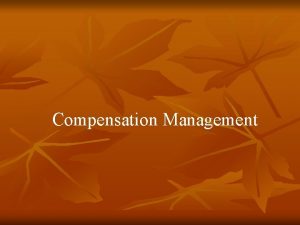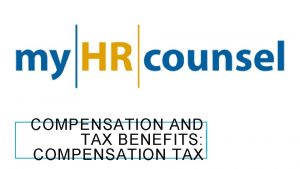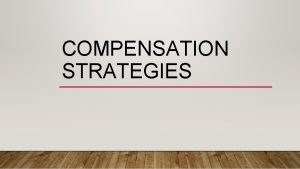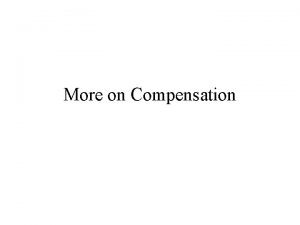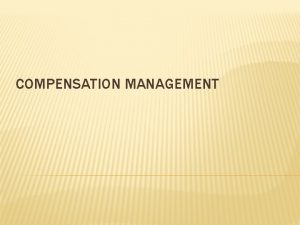Chapter Managing Compensation Managing Human Resources Power Point









































- Slides: 41

Chapter Managing Compensation Managing Human Resources Power. Point Presentation by Monica Belcourt, York University and Charlie Cook, The University of West Alabama

Learning Outcomes After studying this chapter, you should be able to: 1. 2. 3. 4. 5. Explain employer concerns in developing a strategic compensation program. Indicate the various factors that influence the setting of wages. Differentiate the mechanics of each of the major job evaluation systems. Explain the purpose of a wage survey. Define the wage curve, pay grades, and rate ranges as parts of the compensation structure. Copyright © 2011 by Nelson Education Ltd. 9– 2

Learning Outcomes (Cont’d) After studying this chapter, you should be able to: 6. 7. Identify the major provisions of the laws and regulations affecting compensation. Discuss the current issues of equal pay for work of equal value and pay compression. Copyright © 2011 by Nelson Education Ltd. 9– 3

Compensation q. Pay is a statement of an employee’s worth by an employer. q. Pay is a perception of worth by an employee. Copyright © 2011 by Nelson Education Ltd. 9– 4

T o ta l C o m p e n s a ti o n Direct Indirect Wages / Salaries Time Not Worked Commissions • Vacations • Breaks • Holidays Insurance Plans Bonuses Gainsharing • Medical • Dental • Life Security Plans • Pensions Employee Services • Educational assistance • Recreational programs Copyright © 2011 by Nelson Education Ltd. 9– 5

Goals of compensation To Attract Employees To Retain Employees To Motivate Employees Copyright © 2011 by Nelson Education Ltd. 9– 6

Compensation Management and Other HRM Functions Supply of applicants affects wage rates Aid or impair recruitment Recruitment Pay rates affect selectivity Selection standards affect level of pay required Pay can motivate training Training and Development Increased knowledge leads to higher pay Training and development may lead to higher pay Low pay encourages unionization Copyright © 2011 by Nelson Education Ltd. Compensation Management Labour Relations A basis for determining employee’s rate of pay Pay rates determined through negotiation 9– 7

Strategic Compensation Planning q. Strategic Compensation Planning Ø Links the compensation of employees to the mission, objectives, philosophies, and culture of the organization. Copyright © 2011 by Nelson Education Ltd. 9– 8

Linking Compensation to Organizational Objectives q. Alignment between business strategy and compensation objectives. Ø Change in business strategy requires change in compensation strategy. Copyright © 2011 by Nelson Education Ltd. 9– 9

Common Strategic Compensation Goals 1. To reward employees’ past performance. 2. To remain competitive in the labour market. 3. To maintain salary equity among employees. 4. To mesh employees’ future performance with organizational goals. 5. To control the compensation budget. 6. To attract new employees. 7. To reduce unnecessary turnover. Copyright © 2011 by Nelson Education Ltd. 9– 10

The Pay-for-Performance Standard q. Pay-for-Performance Standard Ø The standard by which managers tie compensation to employee effort and performance. Copyright © 2011 by Nelson Education Ltd. 9– 11

Designing a Pay-for-Performance System q. How will performance be measured? q. How will monies to be allocated for compensation increases. q. Which employees will be eligible? q. How will payouts be made? q. How often will payouts occur? q. How large will the payouts be? q. Will employees perceive the rewards as valued? Copyright © 2011 by Nelson Education Ltd. 9– 12

Motivating Employees through Compensation q. Pay Equity Copyright © 2011 by Nelson Education Ltd. 9– 13

Figure 9– 1 Relationship between Pay Equity and Motivation The greater the perceived disparity between my input/output ratio and the comparison person’s input/output ratio, the greater the motivation to reduce the inequity. Copyright © 2011 by Nelson Education Ltd. 9– 14

Expectancy Theory and Pay q. Expectancy Theory Copyright © 2011 by Nelson Education Ltd. 9– 15

Figure 9– 2 Pay-for-Performance and Expectancy Theory Copyright © 2011 by Nelson Education Ltd. 9– 16

Motivating Employees through Compensation (cont'd) q. Pay Secrecy Copyright © 2011 by Nelson Education Ltd. 9– 17

The Bases for Compensation q. Hourly Work q. Piecework q. Salary Workers Copyright © 2011 by Nelson Education Ltd. 9– 18

The Wage Mix q. How are the wages for my job determined? Internal Factors External Factors Wage Mix Copyright © 2011 by Nelson Education Ltd. 9– 19

The Wage Mix—Internal Factors q. Employer’s Compensation Strategy q. Worth of a Job q. Employee’s Relative Worth q. Employer’s Ability-to-Pay Copyright © 2011 by Nelson Education Ltd. 9– 20

The Wage Mix—External Factors q. Labour Market Conditions q. Area Wage Rates Copyright © 2011 by Nelson Education Ltd. 9– 21

The Wage Mix—External Factors q. Cost of Living Copyright © 2011 by Nelson Education Ltd. 9– 22

Consumer Price Index (CPI) q A measure of the average change in prices over time in a fixed “market basket” of goods and services Copyright © 2011 by Nelson Education Ltd. 9– 23

The Wage Mix—External Factors q. Collective Bargaining Copyright © 2011 by Nelson Education Ltd. 9– 24

Job Evaluation Systems q. Job Evaluation Copyright © 2011 by Nelson Education Ltd. 9– 25

Different Job Evaluation Systems SCOPE OF COMPARISON BASIS FOR COMPARISON Job vs. job Job vs. scale Copyright © 2011 by Nelson Education Ltd. JOB AS A WHOLE JOB PARTS OR FACTORS (NONQUANTITATIVE) (QUANTITATIVE) Job ranking system Factor comparison system Job classification system Point system 9– 26

Job Evaluation Systems (Cont'd) q. Job Ranking System Copyright © 2011 by Nelson Education Ltd. 9– 27

Job Evaluation Systems (Cont'd) q. Job Classification system Copyright © 2011 by Nelson Education Ltd. 9– 28

Point System q. The Point Manual Copyright © 2011 by Nelson Education Ltd. 9– 29

Work Valuation Methods q. Work Valuation Ø A job evaluation system that seeks to measure a job’s worth through its value to the organization. Copyright © 2011 by Nelson Education Ltd. 9– 30

Job Evaluation for Management Positions q. Hay Profile Method Copyright © 2011 by Nelson Education Ltd. 9– 31

The Compensation Structure q. Wage and Salary Survey q. Labour Market Copyright © 2011 by Nelson Education Ltd. 9– 32

Collecting Survey Data q. Outside Sources of Data q. Problems with Surveys Copyright © 2011 by Nelson Education Ltd. 9– 33

The Wage Curve q. Pay Grades q. Rate Ranges q. Red Circle Rates Copyright © 2011 by Nelson Education Ltd. 9– 34

Figure 9– 4 Freehand Wage Curve Copyright © 2011 by Nelson Education Ltd. 9– 35

Figure 9– 5 Single Rate Structure Copyright © 2011 by Nelson Education Ltd. 9– 36

Figure 9– 6 Wage Structure with Increasing Rate Ranges Copyright © 2011 by Nelson Education Ltd. 9– 37

The Wage Curve (cont’d) q. Competence-based Pay q. Broadbanding Copyright © 2011 by Nelson Education Ltd. 9– 38

Government Regulation of Compensation Canada Labour Code Minimum labour standards for all employees falling within federal jurisdiction Employment Standards Acts Example: minimum work week and provision for 1. 5 times in overtime payment. Pay Equity Fair employment practices applied to members of designated groups, regulated provincially. Copyright © 2011 by Nelson Education Ltd. 9– 39

Significant Compensation Issues q. Equal Pay for Work of Equal Value q. Wage-Rate Compression Copyright © 2011 by Nelson Education Ltd. 9– 40

Reducing Wage-Rate Compression q. Give larger compensation increases to more-senior employees. q. Emphasize pay-for-performance and reward meritworthy employees. q. Limit the hiring of new applicants seeking exorbitant salaries. q. Design the pay structure to allow a wide spread between hourly and supervisory jobs or between new hires and senior employees. q. Provide equity adjustments for selected employees hardest hit by pay compression. Copyright © 2011 by Nelson Education Ltd. 9– 41
 Chapter 10 managing human resources
Chapter 10 managing human resources Noncompensation
Noncompensation Managing human resources in small and entrepreneurial firms
Managing human resources in small and entrepreneurial firms Employee selection
Employee selection Managing global human resources
Managing global human resources Managing human resources snell
Managing human resources snell Managing human resources bohlander
Managing human resources bohlander Managing human resources in small and entrepreneurial firms
Managing human resources in small and entrepreneurial firms Managing hospitality human resources
Managing hospitality human resources Managing global human resources
Managing global human resources Designing and managing incentive compensation programs
Designing and managing incentive compensation programs Power triangle diagram
Power triangle diagram Power bi power point
Power bi power point Point de compensation photosynthèse
Point de compensation photosynthèse Prvoir
Prvoir Light compensation point
Light compensation point Light compensation point
Light compensation point Point point power
Point point power Chapter 9 human resource management
Chapter 9 human resource management Chapter 8 human resources culture and diversity
Chapter 8 human resources culture and diversity Chapter 8 test human resources culture and diversity
Chapter 8 test human resources culture and diversity Chapter 5 planning for and recruiting human resources
Chapter 5 planning for and recruiting human resources Chapter 27 human impact on earth resources
Chapter 27 human impact on earth resources Human resource management lecture chapter 1
Human resource management lecture chapter 1 Chapter 9 human resources management
Chapter 9 human resources management Transformed resources and transforming resources
Transformed resources and transforming resources Variable resources definition
Variable resources definition Renewable resources vs nonrenewable resources
Renewable resources vs nonrenewable resources Managing data resources
Managing data resources Managing application resources in a hierarchy
Managing application resources in a hierarchy Importants of hrm
Importants of hrm Data resources in information system
Data resources in information system Information technology resource
Information technology resource Human needs and human development
Human needs and human development Chapter 8 human needs and human development
Chapter 8 human needs and human development Wmata human resources
Wmata human resources Human resources acronyms
Human resources acronyms Uf human resources
Uf human resources Difference between domestic and international hrm
Difference between domestic and international hrm Resource histogram vs responsibility assignment matrix
Resource histogram vs responsibility assignment matrix Project human resource management definition
Project human resource management definition Job design continuum
Job design continuum

